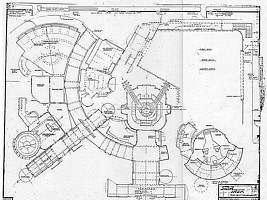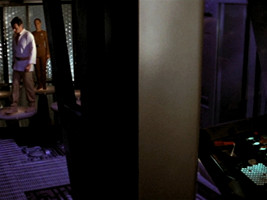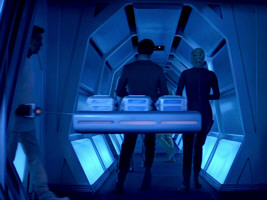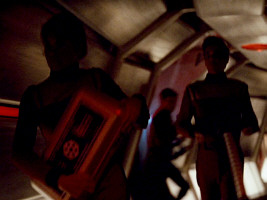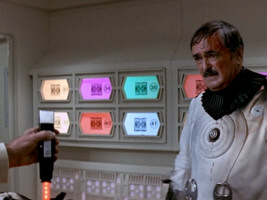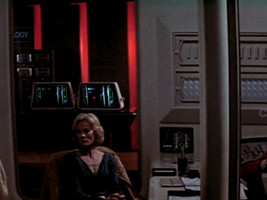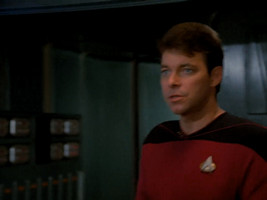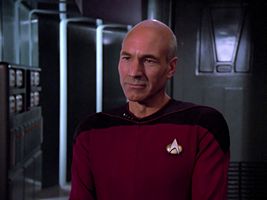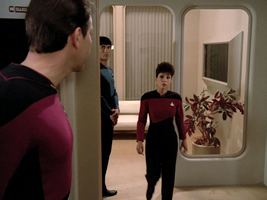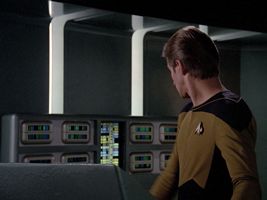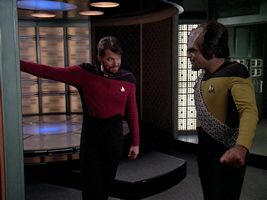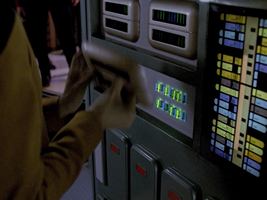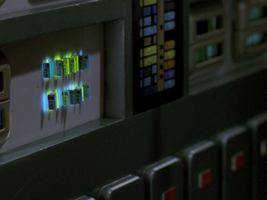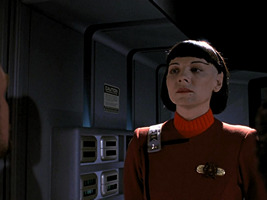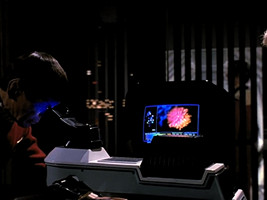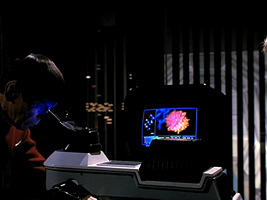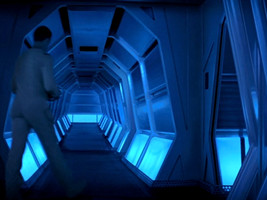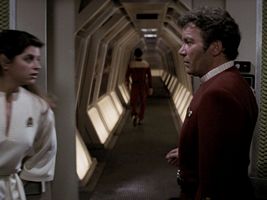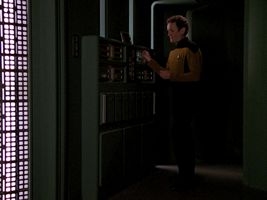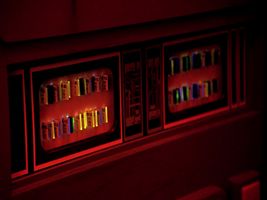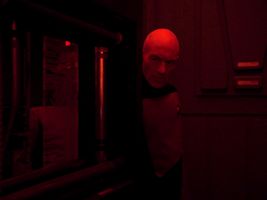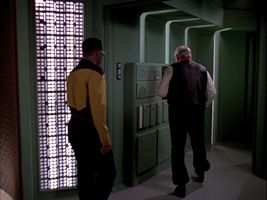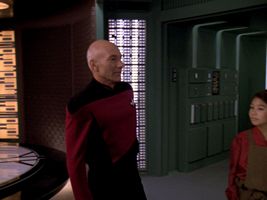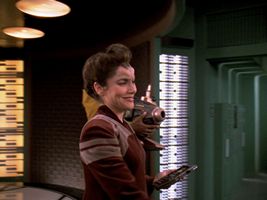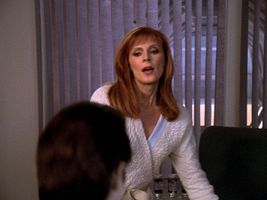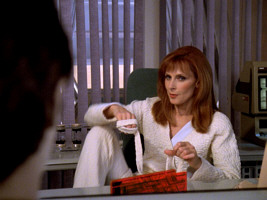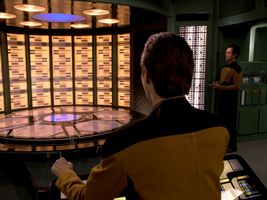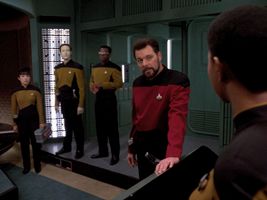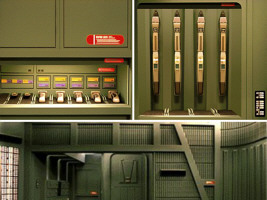The Corridor from the Transporter Room to Sickbay
by Jörg Hillebrand and Bernd Schneider
The set plans for the stage 9 sets at Paramount during the production of "Star Trek: The Motion Picture" reveal an interesting narrow corridor leading from the transporter room to behind the sickbay office windows. The corridor is called "side corridor" and features the word "wild". Going through the first two Star Trek films ("Star Trek III" and "Star Trek IV" do not reveal that part of the set) one can see that interesting small set both in scenes set in the transporter room and the sickbay office. When the sets were re-used on Star Trek: The Next Generation, both the transporter room and the sickbay office were modified.
In this article, we will list all appearances of the short side corridor, both in the transporter room and in sickbay, over the course of 15 years.
Analysis
Star Trek: The Motion Picture
In the first Star Trek feature film, only the small side door in the transporter room is briefly visible. Nobody is seen entering or leaving this door in TMP. There also is no shot of the transporter room in the film allowing a look into the bent corridor.
In the director's cut of the film however, there's an additional scene right before McCoy beams aboard. In that scene, the transporter room is seen from the perspective of the transporter technician and the narrow entrance to the side corridor can be glimpsed a little better.
The sickbay office is seen later in the film when Kirk, Spock and Decker talk about the Ilia probe. Through the windows (one of them actually might be a door) of the office, some kind of shelf can be made out. This shelf has room for ten medical boxes (sample cases).
During the exchange between Kirk, Spock and Decker, three medical crew members are seen walking through the corridor. A female medical officer is putting one of the sample cases into the middle part of the shelf. Those cases look familiar as they often appeared in sickbay on TNG. They feature a label later seen in the TMP Peel-Off Graphics Book. According to the label, those cases are used to keep perishable cultures at cold temperatures. Screenshots from TNG show that the sample cases were in use until the end of the series and once even appeared on DS9. In fact, an antigrav-lift with those cases is seen early in TMP when a medical technician pushes the lift with at least three of the cases through a corridor close to engineering.
We asked Mike Okuda about the shelf and he told us the following:
"The 'shelf' was part of the original TMP set and remained pretty much in place through TNG. It may have moved slightly at the beginning of TNG, but probably not. It was rigged with two slots for full sample case props. These were the two slots that I later replaced with backlit graphics. The remainder of the "cases" on the shelf were just the ends, although they could presumably be pulled out. The full case props remained in use as set dressing in sickbay thru the entirety of TNG."
Star Trek II: The Wrath of Khan
After Kirk, Spock and Saavik have beamed up from the Regula planetoid, they leave the transporter room through the side corridor. In the scene set in the actual transporter room, close to the entrance to the corridor, a wall console can be seen. Next to it, there is a sign with seven lines of instructions. After that, a wall console similar to the first one can barely be made out. The camera then switches to the inside of the corridor. In these shots, the second wall console can clearly be seen and the sign with seven lines of text can barely be made out behind it. The shelf with the 10 medical sample cases is located on the right wall. It looks 100% identical to the shelf visible through the sickbay office windows in the first Star Trek film. In contrast to that appearance, the vertical lines between the wall panels are now lit. The fire extinguisher to the left of the shelf is also new and was most likely added with all the other fire extinguishers before production on the second film started. On the left side of this corridor wall, a table can be seen. Behind the table, there is a large wall console, the words "mode" and "reset" can be made out. To the left of that wall console, some kind of circuitry panel with tubes and boxes is seen. The word "regulator" can be read. This seems to be some kind of tall circuitry panel. The sickbay office windows cannot be made out, they might be located to the left of the circuitry panel.
One thing is rather interesting about the wall shelf: For the medical sample cases that are supposed to be shoved into the shelf (a medical officer is seen or seen faking doing just that in the first Star Trek film) this shelf seems to be rather thin and not deep enough. It seems the medical cases are at least twice the length of this shelf. Mike Okuda says:
"If I recall correctly, the 'shelf' was not a freestanding piece of furniture, but was built as part of the wall, so the prop case would have protruded behind the wall when used for a case."
A little later in the film, a crew member is seen carrying one of the perishable cultures case while running through a corridor.
When the three officers leave the side corridor, they are seen emerging through a door leading to the large corridor set in stage 9. Following their steps from here to corridor set, it can be seen that this was the sickbay office door. For them to actually have left the transporter room corridor, through an open window of the sickbay office set, they'd have to turn right in the corridor where the table was located in the previous shot. The way the shot is cut in the film, they just ran past the sickbay office windows, which weren't visible in that scene, however. No actual connection between the two sets seems to be implied in the film, anyway, but it is interesting to note that as the three officers turn right on the large corridor set, they pass the transporter room door which features a medical logo in this scene. On the corner, they also pass a vertical circuitry panel that is either identical to or the same one as the panel seen in the short transporter room side corridor.
Interestingly, this type of circuitry panel was briefly seen earlier in the film in the main sickbay ward. When Kirk comes into the sickbay examination room to check on Scotty's nephew, he enters and leaves the room through the door leading from the main sickbay ward to the examination room. When the door opens, the circuitry panel is briefly visible. It is 100% identical to the one mentioned twice before. Here, it can also be seen that it is really a thin panel, made for use in corners. When Kirk leaves the examination room through the same door, the camera is positioned in a way that the left border of the panel cannot be seen. The panel was most likely put there for this one scene to have something interesting to look at when briefly looking through the sickbay door.
For a few seconds, when the Reliant is firing at the Enterprise after they have left orbit of the Regula planetoid, the sickbay office is briefly seen with Dr. McCoy sitting at his desk and Carol Marcus sitting opposite him and David Marcus standing in the door, being shaken by the torpedo hit. A few details can be made out about the corridor behind the sickbay windows here. The vertical lines are lit red now, so they must be alert indicators. The table previously seen in the transporter room side corridor is still there, this time two medical monitors from the sickbay biobeds are resting on the table. The wall shelf is still in the same position it was earlier. When comparing its location to the location of the shelf in the first Star Trek film, it can be seen, however, that it has moved to the left. There's now a sign (ending in -LOGY) above the shelf that wasn't there in the previous film or when the set was used as the transporter room corridor, making clear that two different sets are supposed to be seen here. Two crewmembers of the USS Enterprise, one a medical officer, are seen walking through the corridor from left to right. While the camera is shaking, a small part of an unlit wall console is visible on the left. This is the same console that already appeared in the side corridor, only there it was lit and possibly positioned slightly differently. The thin vertical circuitry console is not seen in the sickbay office set.
Prior to TNG
In 1986, the sickbay office set was used to film Gene Roddenberry's introduction to the VHS release of "The Cage", after the first four movies and prior to the modifications for TNG. We can see in the background that the two central sample containers in the side corridor are already missing. It seems they were needed as props somewhere else.
The side corridor itself neither appears in "Star Trek: The Search for Spock" nor in "Star Trek: The Voyage Home". Yet, note the triangular pattern on the windows next to Roddenberry. This is obviously a modification for "Star Trek: The Search for Spock". In fact, we can briefly see a small part of the sickbay office set redressed as the sickbay of the Klingon Bird-of-Prey in "Star Trek: The Search for Spock" but it may have been decided not to film (or to edit out) the newly decorated window.
TNG Season 1
For the first season of TNG, the transporter room set was heavily modified. The entrance to the side corridor was widened and the shelf was moved closer to the transporter room. The back wall of the side corridor with its vertical light slits and including its bend was left more or less untouched. The same can be said for the shelf. As already mentioned, the middle two sample cases were removed and an LCARS display (always turned off in the first season) was put there instead, as Mike Okuda previously confirmed. The shelf itself got a few new labels but the two white vertical stripes on both sides of the shelf and the orange squares on the lower panels are still in place. The blue labels on the backs of the other 8 sample cases were replaced by brown 24th century labels. In "Encounter at Farpoint", the vertical slits were unlit, in all other season 1 episodes, they were lit.
The medical office was also heavily modified but it still features the two back windows. In nearly every TNG episode, those windows are covered by vertical blinds. In "Encounter at Farpoint", however, the blinds are open and a starfield can be seen behind them. A little earlier in the pilot episode, the sickbay office is redressed as a small lounge. In that scene, the vertical blinds are in place and it cannot be seen what is located behind them.
TNG season 2, part 1
In "The Outrageous Okona", the side corridor with the shelf is seen for the first time in the season. The middle LCARS panel is illuminated green in this episode only.
In "Loud as a Whisper", Riker is seen entering the transporter room through the side corridor for the first time. We can see that the shelf has been modified. All the half-cases now only consist of a lid that is mounted to a gray paneling material. The shelf has not officially been transformed into a console wall. The large middle LCARS panel is turned off in this episode but it can be seen that it is recessed now and no longer features a brown label. The brown labels have been removed and those sections of the "lids" are hollowed out, as isolinear chips will be located behind them beginning in "Unnatural Selection". In this episode, the chips are not visible, however.
In "Unnatural Selection", the central recessed LCARS display is lit. The green and blue isolinear chips can clearly be seen through the two openings in each cover. The lower left cover is removed later in the episode and the chips can be seen in their recesses. In order to save Dr. Pulaski in the episode, some modifications need to be made to the transporter. At the end of an exchange in the transporter room, Chief O'Brien says "You heard what he said. Let's get those panels off." to his assistant, explaining why for this episode, the "shelf" was turned into a console/panel with isolinear chips.
Only this episode, there's a second small transporter console located next to the entry to the side corridor. It's presence can also be explained by the script, as at the very end of the episode, when Pulaski is restored, Picard takes over the main transporter console and O'Brien assists him from the second console.
Star Trek V: The Final Frontier
The fifth Star Trek film was filmed, partially on the TNG sets, during the first half of TNG season 2. For this appearance, the shelf was completely removed as can be seen in the screenshots. The second transporter console is however still in place, still featuring the same LCARS display it had in "Unnatural Selection" (and "The Child", when the console first appeared in the cargo bay). It was turned 180°, so the display is facing the room now.
TNG season 2, part 2
The shelf/terminal is briefly visible again at the end of "A Matter of Honor". Its appearance hasn't changed since the last TNG episode. The vertical slits are not lit in this shot but it seems the light source inside the shelf is "leaking" out a little. In "Contagion", the shelf is opened up again. The lower left cover is removed, like in "Unnatural Selection", and the isolinear chips can be seen inside. The panel of the central LCARS display has also been removed and the circuitry (including the bank of isolinear chips, is exposed and pulled out of the recess. Apart from that, the shelf seems unchanged.
TNG season 3
In "The Ensigns of Command", the shelf is briefly seen with open covers again. This time, five covers are removed, all the lower ones and the second one to the right in the top row. Instead of just blue and green isolinear chips, chips of all colors can be seen behind the covers in just this episode.
The central LCARS display has returned but it is no longer recessed but flush with the surface of the shelf. In "Sarek", the green and blue isolinear chips can be seen through the openings in the covers again. It is possible, that behind most of the covers there are no actual chips but that the openings in the covers feature a transparency with green and blue lines, explaining why suddenly the multitude of colors from "The Ensigns of Command" has disappeared.
In "A Matter of Perspective", O'Brien is seen looking at the console. The dark, bending side corridor can be spotted behind him.
In "Ménage à Troi", Wesley is seen entering the transporter room through the side corridor. As he passes the shelf, it is clearly visible that the five locations where the covers were removed in "The Ensigns of Command" now feature brighter green and blue chips seen through the openings. The chips visible through the openings in the remaining three covers are rather dark in contrast. This must have something to do with the new openings that were cut behind the covers for "The Ensigns of command" allowing more light to pass through. This is also very evident in "The Best of Both Worlds I".
TNG season 4
The shelf remains unchanged during all of season 4. In "Brothers", Data enters the transporter room through the side corridor. He removes the cover of the lower second to left isolinear chip bay and the blue and green chips are exposed again. When Data beams away, while still standing in the side corridor, the end of the shortened corridor can be seen. Ever since the beginning of TNG, the corridor has been much shorter than it was in the first two feature films.
In "The Wounded", O'Brien is seen working on the shelf. The lower left cover has been removed and the green and blue chips are exposed.
Star Trek VI: The Undiscovered Country
In the sixth Star Trek feature film, the transporter room side corridor appears mostly unchanged. The film was made between the fourth and fifth season of TNG. The vertical light slits are not lit but, like in "A Matter of Honor", light from the isolinear chip banks "leaks" through where the two slits run behind the shelf. The shelf itself is mostly unchanged, including the 24th century LCARS display, there's only one new sign on the underside of the shelf. Another caution sign can be seen above the shelf on the side corridor wall. The two assassins are seen leaving the transporter room through the side corridor.
The sickbay office also appears in this film, redressed as a science lab. After "Encounter at Farpoint", this is the second time that the vertical blinds are shown opened. Behind the blinds, we can now see a short corridor. Several crewmembers are also walking past the windows.
The plans of stage 9 at the time of TNG (and "Star Trek: The Motion Picture", for that matter) reveal that there is not enough space behind the windows for a proper corridor this length, so what is actually seen here is a painted corridor extension that first appeared in the first Star Trek film on close to the entrance to engineering. The corridor also appeared in "Star Trek II: The Wrath of Khan" when Kirk and Saavik ride a turbolift. It made an appearance in "Encounter at Farpoint" when Data gives Admiral McCoy a tour of the Enterprise-D and reappears here again for the first time. In two more season 6 episodes, this corridor extension would later be seen behind Dr. Crusher's sickbay windows but this appearance in "Star Trek VI: The Undiscovered Country" is the first time the set extension appears behind those windows.
TNG season 5
After the sixth Star Trek film finished production, the whole transporter room was painted in a dull shade of green. The surfaces are no longer reflective and the transporter room side corridor walls and the shelf were also painted with this dull green paint. As we can see in "Darmok", even the orange squares found on the bottom half of the shelf are now painted the same color as the rest of the shelf. Those squares were orange since the first appearance of the shelf in the first Star Trek film in 1979. Another change that first appears here is another small LCARS panel to the left of the shelf.
In this scene, O'Brien has opened the second to right cover in the top row and is working on the isolinear chips. They are green and blue again, like in all previous episodes except for "The Ensigns of Command". Like in previous seasons, five of the covers are lit brighter then the other three, this must have something to with the fact that the other three covers were never seen opened so the light source illuminating them is less bright.
In "Power Play", Chief O'Brien is seen entering the transporter room through the side corridor, carrying a set of three pattern enhancers. This implies that there is some kind of storage room behind the short corridor.
"Cost of Living" marks the only time that the transporter room side corridor (and parts of the transporter room) are redressed as something else. In two scenes, the room appears as an "engineering side room".
The set was bathed in red light, most likely to make it look different from the green transporter room. Geordi is seen scanning large isolinear circuitry (called transfer conduits), parts of a large standing console that was put in front of the transporter room console. He moves a little to the side and in the background the side corridor becomes visible. The upper four isolinear chip slots and even their gray covers are now hidden behind two large panels with two handles each. The lower covers are open and the isolinear chips are exposed. The LCARS display between them is still the same. The lower panels on the console now feature red stickers. LeVar Burton pretends to scan a lower access panel, which is not visible in the scene, and the camera switches to him opening the panel. What follows now is actually a shot of the "shelf" which was seen just a few seconds earlier in the scene. Geordi opens the lower left cover and two rows of isolinear chips can be seen. The gray cover is not present and some black and white framing and black pattern (looking like the inside of an isolinear chip) have been added to the console. The sparkling nitrium parasite suddenly appears and we see Geordi and Data reacting to the sparkles, standing in front of the "imaginary" console again. The sparkles escape through an opening in the engineering sideroom/transporter room ceiling and some goo starts dropping on the isolinear chips back on the close-up of the "shelf".
In the second scene set in the room, Picard enters the side room through the narrow corridor and looks at all the circuitry. The console in the side corridor can be seen again and it can be verified that the close-ups of the parasites and the goo were actually filmed using that console because all of the modifications seen in the close-up are in place here as well. The three officers then leave the side room through the narrow corridor and emerge in engineering through the door located between the chief engineer's office and the warp core. In "Encounter at Farpoint", a turbolift was located here but in all later episode, a side corridor (sometimes with or without a gliding door) is seen, so this is consistent with what has been seen before.
The transporter room side corridor appears once more this season, in "I, Borg" and all the modifications made to the isolinear chip console are still in place. The red stickers can be seen on the lower panels and the two rows of isolinear chip slots and their gray covers are now hidden behind four panels with two handles each.
TNG Season 6
In "Realm of Fear", Barclay is working on the console. All four panels with handles have been removed. All five silver covers, that have been seen removed in earlier episodes, are missing, so the isolinear chips in the same five areas are exposed. Those areas all now feature the black and white pattern seen in "Cost of Living" The area between two arrays of isolinear chips is painted light blue now, something that must have been impossible to see with the red light in the engineering side room. The three remaining covers are still in place. From now on, the silver covers of those five areas will never be shown again, they must have been replaced when the large rectangular covers were added for "Cost of Living". As the other three silver covers were never made to be removed in the earlier episodes, they still must be attached to the shelf, so they were left in place. Again, only green and blue chips are seen. In only one scene in the episode, the lower row of isolinear chips is covered by the two panels. This happens in the middle of a scene of Geordi, O'Brien and Barclay working in the transporter room. At the beginning of the scene, they are all standing in front of the console and all four panels are missing (like in the rest of the episode), then O'Brien and Barclay work on the transporter platform while Geordi is still standing next to the console. In the shots featuring him reacting to what the two other officers are saying, the lower two panels are suddenly attached to the console. Either Geordi reattached them while the others were talking (but no panels were lying on the floor in the earlier scene, or any scene of the transporter room in the whole episode) or this is a blooper.
In "Man of the People", the sickbay office window blinds are seen open for the first time since "Encounter at Farpoint" on TNG. Behind the window, the fake corridor extension that was also in place here in "Star Trek VI: The Undiscovered Country" can be seen. Everything basically looks as it did in the sixth Star Trek feature film so the fake corridor was left in place after filming of the film finished. The starfield in "Encounter at Farpoint" has to be rated as an error in hindsight (unless sickbay was moved since the first season and still looks the same).
In "Relics", Geordi shows Scotty the circuitry behind the four panels, which are all in place. He removes the lower left panel and everything basically looks like it did since "Cost of Living". The isolinear chips do not emit light as brightly as they usually do but that has something to do with the unusually bright way in which the corridor is lit in this episode.
In "Rascals" and the "Quality of Life", the console remains completely unchanged. The covers are in place in both episodes.
In "Quality of Life", the sickbay office blinds are seen open once again and once more, the corridor behind the window looks like it did in Star Trek VI and "Man of the People".
In "Ship in a Bottle", one small modification to the console in the side corridor becomes apparent: the previously red raised squares on the lower panels that were painted over between seasons 4 and 5 are red again beginning in this episode. The lower left panel is seen removed in the whole episode and the upper left panel is removed in one shot.
The console is unchanged in "Birthright II" with all four panels in place. In "Lessons", it is briefly visible with the two left panels removed. Everything underneath the panels still looks like it did since "Cost of Living". In "Second Chances", all four panels seem to be in place but Geordi is standing in front of the two left ones.
Season 7
"Bloodlines" is the only season 7 episode and the last one ever in which the console in the side corridor can clearly be seen. It remains unchanged, however. The red squares and stickers are recognizable on the lower panels. The two left panels and the upper right panel have been removed and the chips and covers are exposed. Everything still looks exactly like it did in "Cost of Living".
Also during season 7, the corridor was apparently covered up with a wall that was supposed to be an equipment locker, visible only on the Interactive Technical Manual and some behind-the-scenes videos.
After "Bloodlines", the transporter room side corridor and its characteristic "shelf"/console, originally created for the first Star Trek film, disappears and is never seen again. Neither in any later TNG season 7 episode nor in "Star Trek: Generations" is this area of the set seen. When the set was completely modified to appear as Voyager's transporter room, the side corridor and the console were removed.
See Also
Changes to the TNG Sets Between Seasons 1 and 2 - several modifications revealed in screen cap comparisons
Credits
The stage plans are taken from Star Trek Stages History. Thanks to Tadeo D'Oria for spotting the modifications in season 7 and to Twitter user mot (@tngliker) for the hint about the sickbay office between the movies and TNG.







 Stage plan for TMP
Stage plan for TMP